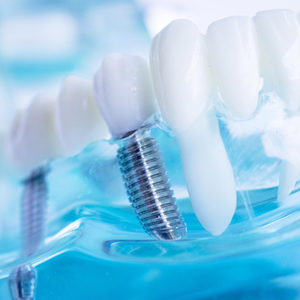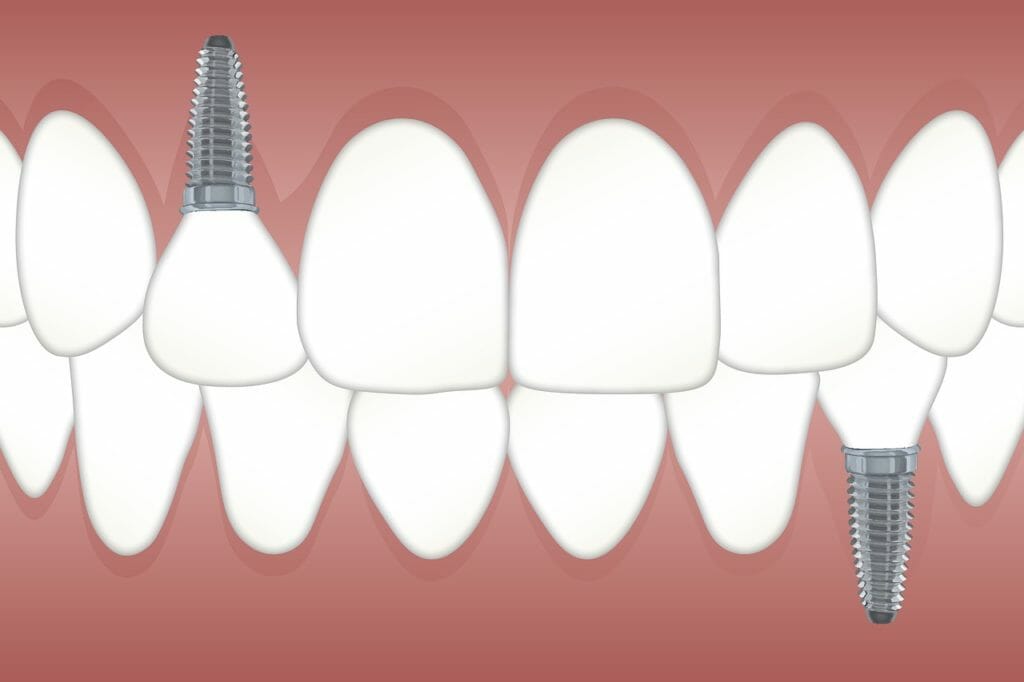Patients who may benefit from dental implants frequently inquire about the recovery period and post-operative care. In this blog, Houston Periodontist, Dr. Kevin Calongne will address that question as well as discuss the methods involved in dental implant surgery.
The procedure for placing dental implants consists of multiple steps, each with its own recovery time and measures to be taken along the way. Depending on the condition of your teeth and jawbone, as well as the number of implants required, each patient’s surgery will be unique. Dr. Calongne will discuss the specifics of your care with you and explain the best method for you as a patient. Some of these processes may be able to be combined in some circumstances, reducing the overall operation and recovery time.
Preparing for Dental Implants
 For some patients, dental implant surgery starts with the extraction of the damaged tooth. This is a standard dental operation, but it can take a few weeks to heal before proceeding. To avoid issues such as dry socket or infection, it is critical to carefully follow your post-extraction guidelines.
For some patients, dental implant surgery starts with the extraction of the damaged tooth. This is a standard dental operation, but it can take a few weeks to heal before proceeding. To avoid issues such as dry socket or infection, it is critical to carefully follow your post-extraction guidelines.
Others may need bone grafting or bone regeneration procedures to strengthen their jawbone. To support the force of biting and chewing with the ultimate replacement tooth, a strong, sturdy bone in the location of the implant is required. Because these surgeries rely on bone mending, full recovery can take six to eight weeks.
Dental Implant Procedure
Dr. Calongne will create a small incision in your gums to access the jawbone, then drill a hole and insert a titanium or ceramic implant to replace the lost tooth roots. Because this is done under anesthesia or sedation, you should not drive afterward and should plan to relax for the rest of the day.
The implant will integrate with the regenerating bone around it and effectively become part of your jaw as the healing process progresses. Titanium or Ceramic is utilized for dental implants because of its ability to form a lasting link with bone tissue. This results in significantly reduced noise and slippage when compared to dentures, as well as improved stability and longevity of the restoration work as compared to fixed bridges.
For cosmetic reasons, if your missing tooth is in the front of your mouth, you may have a temporary replacement tooth put throughout the healing process. This is a type of temporary partial denture that can be removed for cleaning and at night.
Steps to completion
Following the healing of the dental implant, a small attachment called an abutment or collar is often placed on top of the implant. When the crown or replacement tooth is ready, this serves as a foundation for it to be attached to. Local anesthetic is frequently required for the abutment.
For certain patients, the abutment may be attached during the first implant operation, however this means the abutment will be visible above the gum line during the lengthy healing process. Many patients dislike the way that looks, so it is inserted later instead. In either case, the abutment is attached to the implant’s metal post and the gum tissue is closed around it. Your gums will need to heal for about two weeks before the final replacement tooth or teeth can be placed.
Following that, impressions will be taken in order to create your new artificial tooth. These new teeth may be removable or fixed; your dentist will advise you on what is appropriate for your specific situation.
Finally, your new crowns or replacement teeth will be secured to the abutments, and you will be ready to face the world with a new smile. It may take some time to acclimate to the new tooth, so make sure to carefully follow your dentist’s aftercare instructions.
Side Effects to Be Expected
You may have some discomfort during recovery from one or all stages of the implant process, as with any dental surgery. Normal and expected side effects include swelling around the gums and in your face, moderate bruising, pain at the implant site, and little bleeding. It is normally advised to avoid eating hard foods while healing, and your oral surgeon may prescribe pain medication or antibiotics following surgery to aid in your recovery.
If, at any point throughout the healing period, you notice that these issues have gotten worse or are causing too much pain, contact our office immediately to ensure that the problems do not remain.
Taking Care of Your Implants
There are measures you can take to improve the success rate of dental implants. Although the failure rate is extremely low, there is a clear link between smoking and tobacco use and dental implant failure. If you smoke, you should stop before having this surgery to increase your chances of success. If the implant fails, it must be removed, and the surgery must be repeated after a few months.
You can also take efforts to properly care for your teeth and implants after surgery. Brush and floss your teeth and gums on a daily basis to keep your teeth, gums, and dental work clean. Interdental brushes can assist you clean around and between dental implants and your teeth for a more thorough cleaning.
You should also see your dentist on a regular basis to ensure the health of your teeth and implants. And, of course, avoid activities like opening bottles with your teeth, biting on hard sweets or ice, or grinding your teeth at night, which can shatter or damage your teeth or implants.
The best post-implant advice is to disclose any problems to Dr. Calongne as soon as possible. There you have it, dental implants are an important process in returning to optimal oral health and West Houston Periodontics has the experience and staff to make the process run as smoothly as possible. Interested in Dental Implants? Contact Dr. Calongne today for a consultation visit.

